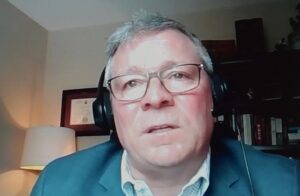Regulatory gaps toxic to Aamjiwnaang First Nation

By Kelly Anne Smith
NIPISSING FIRST NATION— At one time, the shores of the St. Clair River were idyllic and the air clean. Now, Aamjiwnaang First Nation battles industry to clean up their mess and the federal and provincial governments to enforce their own regulations.
Sharilyn Johnston is the Environment Coordinator for Aamjiwnaang First Nation and a member of Chippewas of the Thames First Nation. In a live-streamed presentation to the three-day 5th Annual Anishinabek Nation Lands, Resources and Economic Development Forum Kina-Gego-Naabadosin – We Are All Connected, Johnston says the area deals with a lot of pollution.
“We have been suffering for years. It’s been hard to push the government to make sure that the regulations that they mandated to perform and look after, are actually enforced in our territory.”
Sulpher dioxide rates are 10 times higher for Aamjiwnaang First Nation than Toronto and Ottawa. Sulphur dioxide can decrease fertility in males and females and affect lung function.
Aamjiwnaang First Nation deals with Benzene being 30 times higher than in Ottawa and Toronto. Benzene causes leukemia and other cancers of the blood.
1,3-Butadiene is 27 times higher on the reserve than in London and Ottawa. Exposure to 1,3-Butadiene can increase the incidence of leukemia.
Aamjiwnaang First Nation has over 52 industrial projects as neighbours.

During the presentation, Scott Robertson of Six Nations of the Grand River and associate in the law firm of Nahwegahbow Corbiere, explained that in 2020, a United Nations Special Rapporteur on hazardous substances and waste found that the structure of government contributes to the lack of clarity on the proper forum for seeking justice.
Robertson points to the United Nations Declaration on Rights of Indigenous Peoples Article 32 which states appropriate measures shall be taken to mitigate adverse environmental impacts.
He explains Aamjiwnaang First Nation took matters in hand last year to protect community members and issued a Notice of Violation on a specific benzene-related issue.
“What is going to be the response, both from the government and the company? …These are inherent rights. It would be pretty easy to show that Aamjiwnaang is, in terms of their aboriginal and treaty rights, are being severely impacted by these regulations that aren’t being enforced.”
Robertson says the First Nation would be treated differently in the United States where the environment is regulated federally.
“The EPA has a lot of power in the United States. It would literally file a notice similar to this, a Notice of Violation. If the company doesn’t take direct action, the next step is the EPA will shut down your facility.”
Aamjiwnaang First Nation’s Environmental Coordinator points to a health study in the works. Johnston says it was the Minister of the Environment of the previous Liberal government who supported a health study on community members.
“Prior to that, we couldn’t find funding. Nobody would support the health study. We’ve had two years of working with the government on that. What it looks like, what is an exposure study and what is it going to be when it comes to the community,” he explained. “As far as cancer rates, there are a lot of anecdotal stories related to cancer. Since I’ve been here since 2007, I’ve had ten people that I worked with, at least, pass away due to cancer.”
“When you look at our deaths in the community, we probably lose a community member a month according to the stats in our audit on how much we spend on graves and on funerals,” he added. “About one person a month that we lose to an illness. Whether that be to cancer or heart disease or that type of thing.”
Johnston assures that the First Nation is working to assert our rights. She adds that using Notice of Violation is a way to do it to get rid of that regulatory gap that we are all facing.
“Start putting these types of tools and instruments in play and it will be better for your community. You will have the control and you can say these are the conditions and this is what we want done,” she expressed. “If you say to the government, ‘You’re next for a Notice of Violation,’ I’m sure you are going to get some movement with the agencies and the industry…the numbers are bad, but overall, we are asserting our rights so that the community is protected.”


